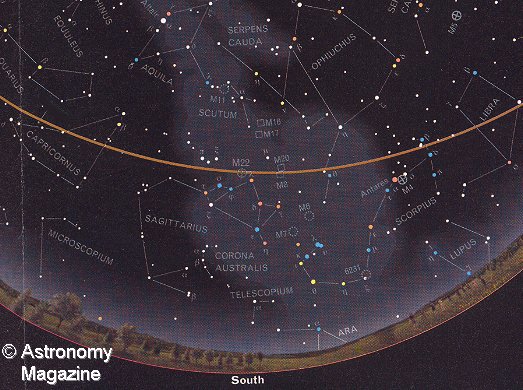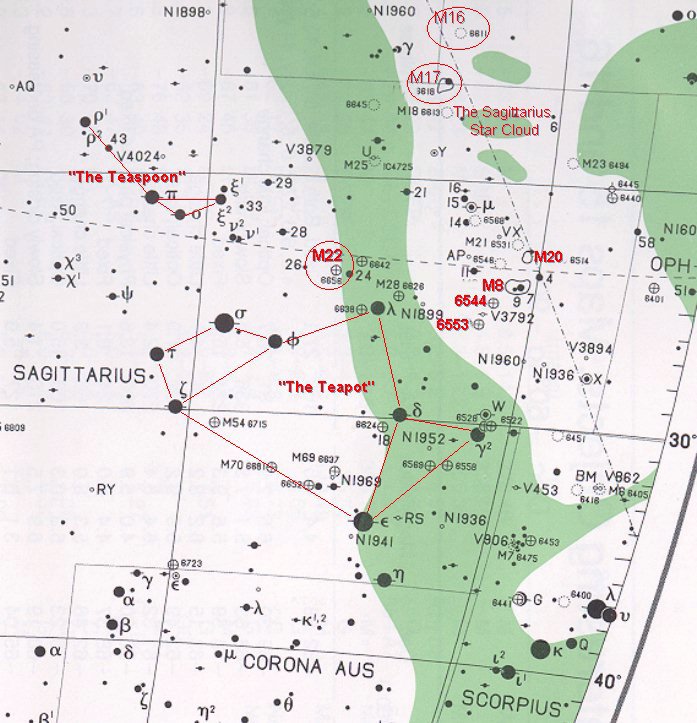July 2004
Sagittarius
Check out the COTM Archive
Also view other Summer constellations Scorpius and Cygnus.
 The magnificent
"Summer Milky Way" is in prime viewing position in July and August.
If you have a clear southern horizon, you can see the Milky Way running
upwards through Scorpius and Sagittarius, high overhead through Cygnus
the Swan, and then all the way down to Cassiopeia, low on the northeastern
horizon. This month we focus on Sagittarius, and within its boundaries,
the heart of our galaxy.
The magnificent
"Summer Milky Way" is in prime viewing position in July and August.
If you have a clear southern horizon, you can see the Milky Way running
upwards through Scorpius and Sagittarius, high overhead through Cygnus
the Swan, and then all the way down to Cassiopeia, low on the northeastern
horizon. This month we focus on Sagittarius, and within its boundaries,
the heart of our galaxy.
The classical figure of Sagittarius represents an archer, but Northern
hemisphere skywatchers have come to know this constellation as the "Teapot".
On the image below we have "connected the dots" to show you its shape,
as well as the "Teaspoon", floating to the upper left of the teapot.
The heart of our Milky Way galaxy lies in the direction of Sagittarius
, and is only one distinction that makes this constellation special. Sagittarius
is also home to the Winter Solstice (the southernmost point in the sun's
path on the ecliptic. The Winter Solstice heralds the beginning of Winter
in the Northern Hemisphere, and the beginning of Summer in southern latitudes.)
In addition, Sagittarius is also the record holder of the constellation
with the most Messier objects (15 in all.)

In this larger, more detailed view (adapted from Norton's Sky Atlas
2000.0), we'll take a closer look at some of the interesting sights
in Sagittarius. Our tour goes in order of Right Ascension, which is right
to left on this map. We also provide some links to showcase Jason
Ware's personal astrophotography exhibit. The symbols below show how
an object is best viewed:
 with your naked eye;
with your naked eye;
 with binoculars, and
with binoculars, and
 with a telescope.
with a telescope.
 M20, The Trifid
Nebula. One of the most famous Messier objects, mainly because the
Trifid is very photogenic. It comes out on film as a stunning pink and
blue complex with three dark dust lanes running through it. These dark
lanes are visible with a 6 to 8 inch telescope from a dark sky site. You
won't see any color, however; the nebulosity that is visible is grey. Jason
Ware's awesome image of the Trifid.
M20, The Trifid
Nebula. One of the most famous Messier objects, mainly because the
Trifid is very photogenic. It comes out on film as a stunning pink and
blue complex with three dark dust lanes running through it. These dark
lanes are visible with a 6 to 8 inch telescope from a dark sky site. You
won't see any color, however; the nebulosity that is visible is grey. Jason
Ware's awesome image of the Trifid.
 M8, The Lagoon
Nebula. We nicknamed the Lagoon "The Orion of the South." The Lagoon
is arguably easier to see with the naked eye than the famous Orion Nebula.
It is equally beautiful in photos. Through virtually any size telescope
you will be able to the cluster of young stars associated with the Lagoon,
as well as the wispy nebulosity of the nebula itself. Jason's image of
the Lagoon and Trifid region.
Our
image of the Lagoon.
M8, The Lagoon
Nebula. We nicknamed the Lagoon "The Orion of the South." The Lagoon
is arguably easier to see with the naked eye than the famous Orion Nebula.
It is equally beautiful in photos. Through virtually any size telescope
you will be able to the cluster of young stars associated with the Lagoon,
as well as the wispy nebulosity of the nebula itself. Jason's image of
the Lagoon and Trifid region.
Our
image of the Lagoon.
 NGC 6544. Just
southeast of the Lagoon complex lies the small globular cluster NGC 6544.
This glob lies in a dense starfield, and should be visible with a 4 1/2
inch reflector. More
info and picture.
NGC 6544. Just
southeast of the Lagoon complex lies the small globular cluster NGC 6544.
This glob lies in a dense starfield, and should be visible with a 4 1/2
inch reflector. More
info and picture.
 NGC 6553. Draw
a line through the Lagoon and NGC 6544 and you will come to NGC 6553, another
globular "companion" to the Lagoon. In reality, these objects are separated
by thousands of light years. The Lagoon is part of the Milky Way, while
globular clusters form a halo around our galaxy. More
info and picture.
NGC 6553. Draw
a line through the Lagoon and NGC 6544 and you will come to NGC 6553, another
globular "companion" to the Lagoon. In reality, these objects are separated
by thousands of light years. The Lagoon is part of the Milky Way, while
globular clusters form a halo around our galaxy. More
info and picture.
 M24, The Sagittarius
Star Cloud. While not a true "cluster", the SSC is compact and dense
enough that Charles Messier designated a number for it in his catalog of
"non comets". On our map above, it is the large oval of green. Although
it is best seen with the naked eye and binocs, make sure to explore this
region with a scope. It is one of the densest concentrations of stars you
will ever see.
M24, The Sagittarius
Star Cloud. While not a true "cluster", the SSC is compact and dense
enough that Charles Messier designated a number for it in his catalog of
"non comets". On our map above, it is the large oval of green. Although
it is best seen with the naked eye and binocs, make sure to explore this
region with a scope. It is one of the densest concentrations of stars you
will ever see.
 M16, The Eagle Nebula.
M16 and 17 are actually located in the constellation Serpens, but we
had to include them in our Sagittarius tour. M16 is difficult to observe
visually. The associated star cluster stands out in any size scope, but
the famous red nebulosity that surrounds it is elusive. Jason's image of
the Eagle Nebula.
(The "Eagle" is the small black region in the center.)
M16, The Eagle Nebula.
M16 and 17 are actually located in the constellation Serpens, but we
had to include them in our Sagittarius tour. M16 is difficult to observe
visually. The associated star cluster stands out in any size scope, but
the famous red nebulosity that surrounds it is elusive. Jason's image of
the Eagle Nebula.
(The "Eagle" is the small black region in the center.)
 M17, The Swan
Nebula. The Swan is one of the best nebulae you'll ever see.
Not only is it bright and easy to see in small scopes, but it actually
looks like a swan, floating gracefully on the water with its neck bowed.
Pay special attention to the neck region, and bump up the magnification.
The area inside the neck looks like a black hole, devoid of all but a few
stars. Also, a beautiful, bright yellow star next to the swan adds contrast.
To see the swan as it looks in a medium sized (8" or 10") scope, click
here. Also check out our
image of the swan, Jason's digital
image, and finally, Jason's image of the M16
and M17 region.
M17, The Swan
Nebula. The Swan is one of the best nebulae you'll ever see.
Not only is it bright and easy to see in small scopes, but it actually
looks like a swan, floating gracefully on the water with its neck bowed.
Pay special attention to the neck region, and bump up the magnification.
The area inside the neck looks like a black hole, devoid of all but a few
stars. Also, a beautiful, bright yellow star next to the swan adds contrast.
To see the swan as it looks in a medium sized (8" or 10") scope, click
here. Also check out our
image of the swan, Jason's digital
image, and finally, Jason's image of the M16
and M17 region.
 M22. Our
final stop on the Sagittarius grand tour is one of the most magnificent
globular clusters in the entire sky. At magnitude 5.1, it is actually brighter
than its more famous cousin, M13 (5.9) M22 is easy to find, just northeast
of l (lambda) Sag. At a distance of 10,000 light
years, M22 is one of the nearest globulars to earth. Also, it lies within
one degree of the ecliptic, which means that planets sometimes pass by
it. In 1996, the planet Jupiter glided through the M22 region, providing
a fantastic contrast in a low power telescope field. Credit
for this info, and an image gallery of M22.
M22. Our
final stop on the Sagittarius grand tour is one of the most magnificent
globular clusters in the entire sky. At magnitude 5.1, it is actually brighter
than its more famous cousin, M13 (5.9) M22 is easy to find, just northeast
of l (lambda) Sag. At a distance of 10,000 light
years, M22 is one of the nearest globulars to earth. Also, it lies within
one degree of the ecliptic, which means that planets sometimes pass by
it. In 1996, the planet Jupiter glided through the M22 region, providing
a fantastic contrast in a low power telescope field. Credit
for this info, and an image gallery of M22.
There are many more fascinating objects to explore in Sagittarius, with
binoculars and a telescope. On the map above there are lots of globular
clusters which we did not touch on. Most of these are identified by a 4
digit number, which refers to the NGC catalog. To make an observing list,
visit the Interactive
NGC Catalog Online, type in the number of the object, and check its
size and brightness. You can also download an image of every single NGC
object.
Back to Night Sky Observers Page
 The magnificent
"Summer Milky Way" is in prime viewing position in July and August.
If you have a clear southern horizon, you can see the Milky Way running
upwards through Scorpius and Sagittarius, high overhead through Cygnus
the Swan, and then all the way down to Cassiopeia, low on the northeastern
horizon. This month we focus on Sagittarius, and within its boundaries,
the heart of our galaxy.
The magnificent
"Summer Milky Way" is in prime viewing position in July and August.
If you have a clear southern horizon, you can see the Milky Way running
upwards through Scorpius and Sagittarius, high overhead through Cygnus
the Swan, and then all the way down to Cassiopeia, low on the northeastern
horizon. This month we focus on Sagittarius, and within its boundaries,
the heart of our galaxy.
